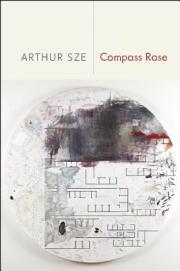 Arthur Sze
Arthur Sze
Copper Canyon Press ($16)
by Ted Mathys
In Arthur Sze’s stunning tenth collection, he departs from previous books by adopting new formal techniques to illuminate one of his enduring themes: how to account for the simultaneity of lived events in a poetic language that is damned to unfold over time. The book opens with an untitled page consisting of a single line of verse: “Black kites with outstretched wings circle overhead—.” After each titled poem in the collection another page like this appears, with a few unrelated image-lines, each ending with an em-dash. Their content slowly accumulates into travel journal, with images suggesting South Asia. The em-dashes leap out manically from the ends of the lines as if to suggest that something is about to happen or just happened to the traveler, but the transcription process couldn’t keep pace: “A naked woman applies kohl to her right eyelid— / The limp tassels of new ashoka leaves in a tomb courtyard—.”
Buried in the acknowledgments at the end of the book is the explanation that these lines belong to a single poem, “Sarangi Music,” which was first published as a whole but here appears in segments, dispersed, and stripped of its title. “Sarangi Music” thus exists for the reader in two places at once; it is posited as an ideal construct residing somewhere else but is experienced here in flickering, periodic fragments. This is the magic of Sze’s poetry. He creates artifacts in which the profusion of each present moment can be felt viscerally if not fully understood, in which “each fragment is a whole” precisely because “Consciousness is an infinite net / in which each hanging jewel absorbs and reflects / every other.”
Like much of Sze’s work, Compass Rose is anchored by numbered, serial poems driven by paratactic images and overheard snippets of language laid down in rapid succession. Sze privileges active present tense verbs (“an owl lifts,” “kiwis hang,” “he swerves,” “surf slams,” “two planets bob”) and temporal ligatures like “while” and “as” that make the actions in his poems feel coincident rather than causal. Though Sze sometimes adopts a deeply emotional lyric “I,” more often the work is peopled with characters who are typecast by occupation—“At the lab a technician prepares a response / to a hypothetical anthrax attack”; “A healer aligns / her east and west”; “A veteran’s wince coincides / with the pang a girl feels when / she masters hooked bows in a minuet”—all of which deepens the feeling that each of us is not an inviolably unique person, but rather an actor embedded in a larger web of physical life.
This goes for the poet, too. Even as he mines his surroundings for sensuous lines of verse, Sze’s speaker seems consistently aware of the limits of human perception and our insignificance, to borrow a brutal phrase from Mao, “as far as the universe as a whole is concerned.” In many ways the book is governed by a desire to contend with this in language, to make palpable the elusive natural forces that structure the present: “If I sprinkle iron filings onto a sheet / of paper, I make visible / the magnetic lines of the moment.” Magnetic lines, state lines, nanoseconds, meteorological isobars, ultraviolet radiation—Sze’s wide aperture, observational precision, and sustained intellectual pressure transform what seems beyond the grasp of the human senses into events in language.
In the compass rose, Sze finds an elegant metaphor for this poetics. A compass rose is the figure on a compass or nautical map that depicts the cardinal directions: North, East, South, and West. In its crudest form it resembles a four-pointed star, but many designs bisect the cardinal directions into smaller units such as Northeast, East-Northeast, and so on. The more precise the observational units on a compass get, the more its lines proliferate, and the more the pointed star begins to resemble an ornate rose in bloom.
Like a compass rose, Sze’s meticulous examinations of scientific phenomena ultimately yield aesthetic rewards, and what appears at first to be plainly aesthetic, such as “the heart-shaped leaves of spring,” is often revealed to be an illusory aspect of a more complicated system in which “dark energy and dark / matter enlace this world.” Indeed, in the title poem Sze draws a parallel between this scientific-aesthetic tension and the poetic tension between literal and figurative uses of language. “What closes and is literal, / what opens and is figurative?” he writes, only to reverse the aphoristic question a few lines later: “what closes / and is figurative, what opens and is literal?” These poems vibrate in the hidden, interstitial spaces between open and closed, literal and figurative, science and art, the land and its maps, the compass and the rose.

